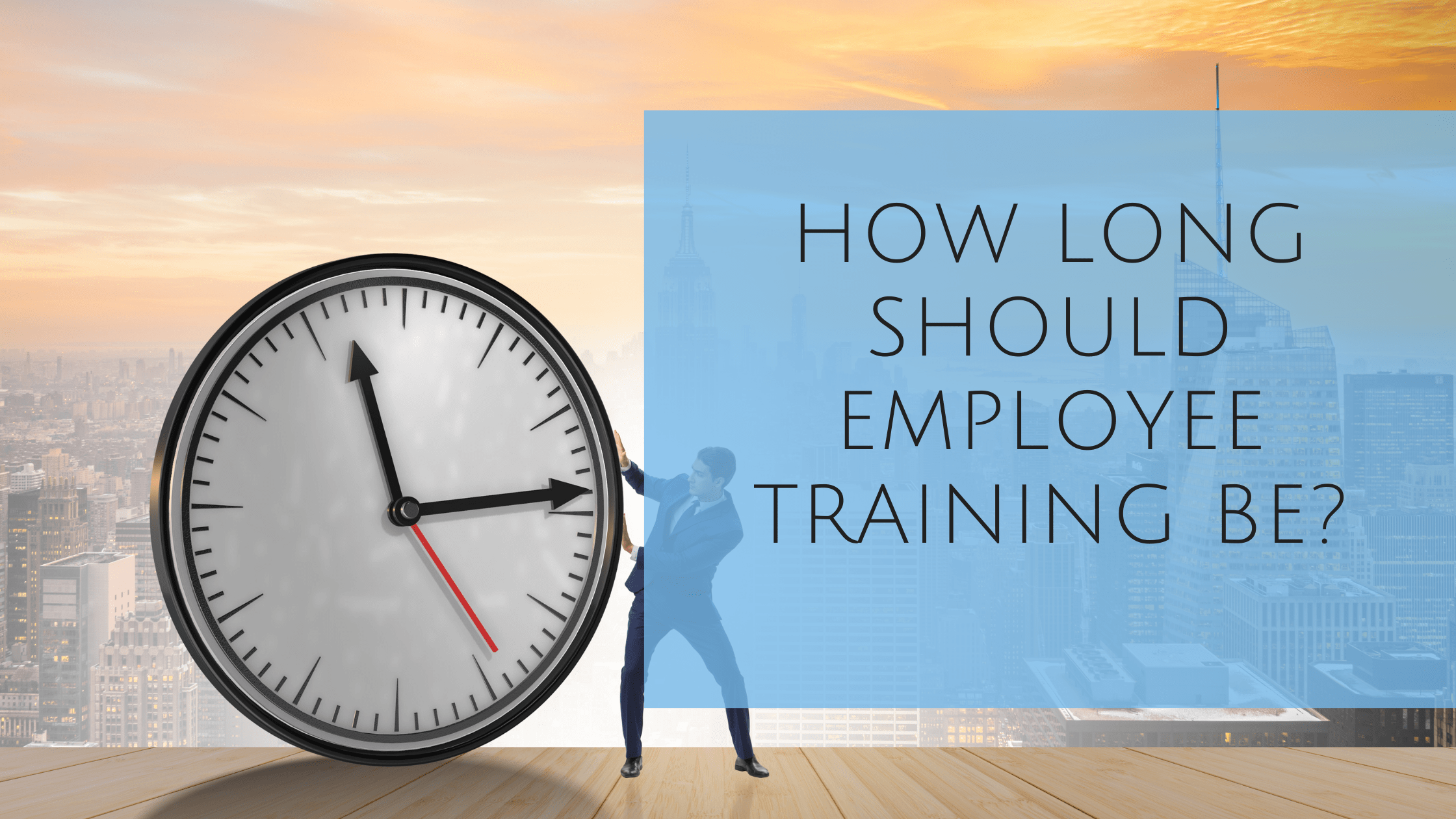When creating a training class, one of the first questions you might have is how long should the training be? The short answer is…it depends. There are many factors that can contribute to the length of your class. Is it in person? Virtual? Self-paced? Instructor-led? How much content is there? These are all things that can impact the timing. Here are some general guidelines I use for various types of training.
Instructor-Led, In Person: For this type of training, you have the most leeway. Training time can range from 30 minutes to a week or more. It will depend on the training program and what needs to be taught.
Instructor-Led, Virtual: Teaching through the computer is very different from teaching in person. I like to keep a virtual training session to an hour or less. If it needs to be longer, then it needs to be very carefully thought out as to how it will be structured and how you will allow for breaks. I would also consider holding separate one hour modules that are spread out over several days or weeks (depending).
Self-Paced Learning: E-learning courses should usually be around 15 – 30 minutes total. Some self-paced learning such as videos can be a lot shorter: 3 – 5 minutes.
These are just some general guidelines. Read on for more information and details on each training course type.
Instructor-Led, In Person
Total Length
The total length for an in person, instructor-led class will depend on what is being taught. Some sessions will be an hour or less. Some will be a half day or full day. Some may go for a whole week or more.
There may also be business factors that influence the length of the course. For example, you might be told \”this class can\’t be any longer than 1/2 a day\” in which case you may have to conform to the time you are given.
Ideally, you will build out the course to fit the best, most relevant content needed to effectively teach the learners. So, if you only need an hour to do that, then create an hour long class. If you have several topics that need to be covered as part of something like a new hire orientation, then you may need a day or two.
Section Length
When we talk about how long training should be, it\’s not just the total that we need to look at. You need to think about each section and how long to allow for instruction along with interaction and breaks.
Unfortunately, this is pretty much ignored in most training sessions. Most training tries to cram in as much content as humanly possible with little or no regard to the humans that are being trained.
In an hour of classroom time, there really should only be about 15 – 20 minutes of instruction before giving the learners some kind of an activity or interaction break. In reality, most trainers/presenters talk for the entire hour or longer and then, maybe, check to see if there are questions. Is it any wonder, then, why most of us groan when we are told we have to attend a training class?
When I say 15 – 20 minutes, that doesn\’t necessarily mean there can\’t be more instruction than that. It\’s just that, mentally, the learners need some kind of a break, activity or interaction in between to help keep their focus. This is very challenging for most trainers, especially subject matter experts who have been brought in to train. Everyone thinks their content is so precious and that the learner must consume every last drop!
The majority of your audience does NOT have a photographic memory. They are only going to retain a small percentage of what is covered. That\’s why God created job aids. If there is content that you want them to be able to access later, put it in a job aid. Instead of filling an hour with a bunch of content that will be forgotten anyway, zero in on the most important things they need to know now and use the rest of the time to reinforce that with an activity.
When it comes to multi-day or multi-hour classes, you also have to account for breaks. I don\’t like to go more than an hour without giving some kind of a break. Not an activity. An actual break from the class. Even if it\’s just a five minute stretch break, something is better than nothing.
I\’ll be the first to tell you that adhering to these recommendations is tough. There are going to be things beyond your control and people who will insist on barreling through all of their content. Just make sure to advocate for your learners as much as possible. Build in meaningful activities and offload what you can into job aids or other resources.
Instructor-Led, Virtual
Timing for an instructor-led virtual class is even more challenging. As with in person training, it is recommended to limit the time for lecturing/instruction. Ideally, I\’d want a virtual training to only be an hour at most. Shorter is better.
The reality is, we are being asked more and more to schedule multi-hour and even multi-day virtual classes. I try to follow the same guidelines as I mentioned for in person. Keep the lecturing to a minimum and focus on interactivity.
When doing a full day or more, I\’d say to make the \”day\” more like 4 hours. And, you will want to build in LOTS of breaks throughout. In spite of how technology keeps getting better and makes it easier to hold training virtually, it still isn\’t the same as being together in person.
Don\’t get me wrong. There are a lot of great, creative ways to conduct virtual activities. You just want to be very mindful of the learners and how fatiguing sitting in a virtual meeting can be for long periods.
If you don\’t believe me about the additional fatigue involved with long virtual training sessions, check out what the eggheads at Stanford have to say: Zoom Fatigue
Self-Paced Learning
When creating an e-learning course or other self-paced training, the timing is a bit more straight forward. I shoot for 15 – 30 minutes. If I have too much content to fit that then I look at creating a separate course.
For a stand alone training video, I go for much less. Maybe 3 – 5 minutes.
Why so short? If you think about it, why do we create self-paced learning in the first place? The point of making self-paced learning is to give the learners something they can complete on their schedule. Most of your audience will be very busy with their \”real\” jobs. They don\’t have a lot of time to spend sitting through an e-learning module of any length, let alone one that goes beyond 30 minutes.
The other part of this is our shrinking attention spans. We are all inundated with information all day every day. Emails, podcasts, television, YouTube, social media… It\’s harder and harder for people to stay focused on any one thing for a sustained period of time.
TikTok is one of the hottest social media platforms going right now. How long is a TikTok video? 60 seconds max. YouTube has taken notice of this and has started introducing YouTube Shorts. How long are shorts? 15 – 60 seconds. You get the idea.
Wrap Up
As learning creators, we are going to be challenged more and more to shrink the amount of time our training takes to consume. At the same time, we will continue to be expected to provide valuable learning experiences.
Whether it\’s in person, virtual or self-paced, it is important to take the timing into serious consideration. The shrinking timelines, while challenging, may also be a good thing as we are forced to cut away at the \”fluff\” and leave only the most relevant content for the learners.


Pingback: 8 Tips for Engaging Your Learners in a Virtual Training Session - Your Learning Career